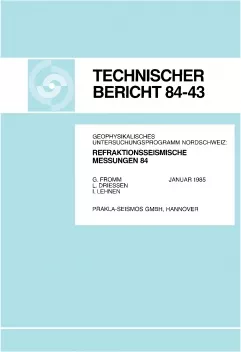
Technischer Bericht NTB 84-43
Geophysikalisches Untersuchungsprogramm Nordschweiz: Refraktionsseismische Messungen 84
Acting on instructions from the SGPK/Nagra working group (Baden, Switzerland), PRAKLA-SEISMOS GmbH, Hanover, planned, processed and interpreted seismic refraction measurements in northern Switzerland; CGG, Massy (France) was responsible for carrying out the field work. The aim of the survey was to investigate the shape and depth of a regional, WSW-ENE striking Permocarboniferous trough which underlays the mesozoic sediments of the Tabular Jura. The crystalline basement surface and possibly other geological boundaries were to be identified on the basis of refractor velocities. The recording arrangement included a 36 km spread in the assumed trough axis and four 12 km long spreads perpendicular to the axis (broad-side "T") which covered the trough edges. The resulting good quality data indicated two refractors: horizon H5 which is attributable to the lower Permocarboniferous could only be detected in the western half of the spread with any certainty. Horizon H6 probably represents the crystalline basement surface. If anisotropy is taken into account, the refractor velocity closely corresponds to the Gneiss of the WEIACH- and the Granite 3 of the BÖTTSTEIN-borehole. This horizon was clearly discernible on all recordings and allowed the approximate mapping of the trough's shape. The assumed strike direction and depth was largely confirmed. In the WSW section the trough is more than 3300 m deep, it rises to -3000 m in the ESE section and shows only in the east of the survey area a tendency towards a narrower width and shallower depth (depth data relate to the seismic reference datum at 500 m above MSL).
